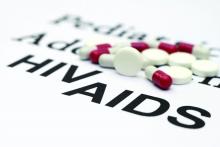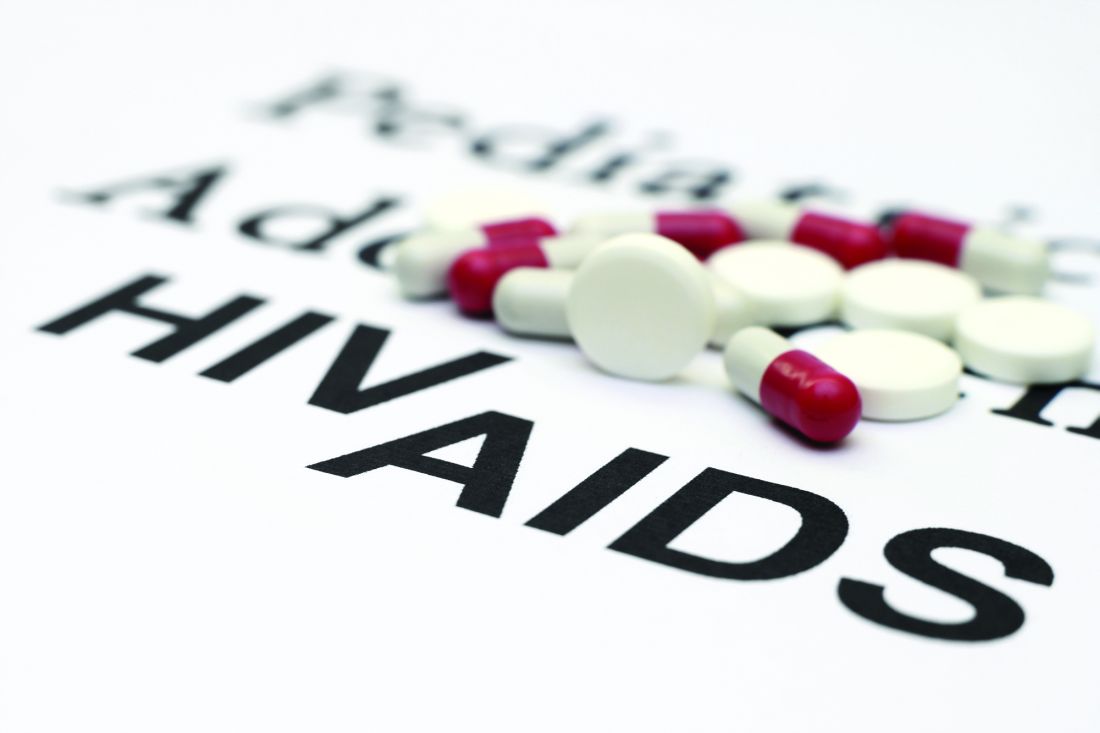User login
SAN DIEGO – Young adults with perinatally-acquired HIV are at an increased risk of developing hypertension, according to a study presented at IDWeek 2017, an infectious diseases conference.
With advances in HIV care and treatment increasing the lifespan of perinatally infected children, patients are seeing increased risks of HIV-associated, non-AIDS conditions like hypertension.
While the prevalence of hypertension in older HIV patients has been studied thoroughly, rates among younger, perinatal HIV populations is relatively unexplored, said Dr. Ryscavage.
Investigators examined 324 patients between the ages of 18-29 years, split between three arms for a cross sectional study: 108 patients with perinatally-acquired (PA) HIV, 108 patients with non-perinatally acquired (NPA) HIV, and 108 uninfected (UI) patients. The 3 study arms were a median age of 24 years, 95% black, and a slight majority female.
Dr. Ryscavage and fellow investigators defined systemic hypertension as two systolic blood pressure measurements greater than or equal to 140 mmHg, or diastolic measurements greater or equal to 90 mmHG within 3 months, or if a physician prescribed antihypertensive mediation.
The researchers discovered that, while UI patients had the highest prevalence of obesity, PA patients reported the highest rate of chronic kidney disease (19%) and dysplidemia (13%), compared to NPA (1% and 3% respectively) and UI (0% and 5% respectively) patients.
Hypertension prevalence was highest among PA patients, followed by NPA patients, and then UI at 23%, 10%, and 9% respectively.
Young adults with PA HIV were nearly 5 times as likely to have hypertension (aOR 4.7; CI 95% [1.9-11.5]) compared to the uninfected population, while NPA showed no significant difference compared to the uninfected (aOR 1.7; CI 95% [.7-4.6]).
Investigators checked to see if the increase in hypertension could be related to the high rate of chronic kidney disease, but were not successful.
“We found [chronic kidney disease] to be approximately one third increased odds of association with chronic kidney disease,” Dr. Ryscavage explained. “However excluding kidney disease, the prevalence odds ratios remained significant and in the context of the cross sectional study…it was difficult to establish a directional relationship between chronic kidney diseases and hypertension.”
This study was limited by using one center in West Baltimore. Also, due to a majority of patients having at least one deceased parent, investigators were not able to collect a complete family history.
Dr. Ryscavage and his colleagues are next looking for what specific factors in HIV groups are causing an increased prevalence. Meanwhile, the investigators implored other researchers to initiate studies in poorer nations where HIV is much more prevalent.
“These findings need to be explored in the developing world where we have the largest population of aging, perinatally infected patients,” said Dr. Ryscavage.
Presenters reported no relevant financial disclosures.
[email protected]
On Twitter @eaztweets
SAN DIEGO – Young adults with perinatally-acquired HIV are at an increased risk of developing hypertension, according to a study presented at IDWeek 2017, an infectious diseases conference.
With advances in HIV care and treatment increasing the lifespan of perinatally infected children, patients are seeing increased risks of HIV-associated, non-AIDS conditions like hypertension.
While the prevalence of hypertension in older HIV patients has been studied thoroughly, rates among younger, perinatal HIV populations is relatively unexplored, said Dr. Ryscavage.
Investigators examined 324 patients between the ages of 18-29 years, split between three arms for a cross sectional study: 108 patients with perinatally-acquired (PA) HIV, 108 patients with non-perinatally acquired (NPA) HIV, and 108 uninfected (UI) patients. The 3 study arms were a median age of 24 years, 95% black, and a slight majority female.
Dr. Ryscavage and fellow investigators defined systemic hypertension as two systolic blood pressure measurements greater than or equal to 140 mmHg, or diastolic measurements greater or equal to 90 mmHG within 3 months, or if a physician prescribed antihypertensive mediation.
The researchers discovered that, while UI patients had the highest prevalence of obesity, PA patients reported the highest rate of chronic kidney disease (19%) and dysplidemia (13%), compared to NPA (1% and 3% respectively) and UI (0% and 5% respectively) patients.
Hypertension prevalence was highest among PA patients, followed by NPA patients, and then UI at 23%, 10%, and 9% respectively.
Young adults with PA HIV were nearly 5 times as likely to have hypertension (aOR 4.7; CI 95% [1.9-11.5]) compared to the uninfected population, while NPA showed no significant difference compared to the uninfected (aOR 1.7; CI 95% [.7-4.6]).
Investigators checked to see if the increase in hypertension could be related to the high rate of chronic kidney disease, but were not successful.
“We found [chronic kidney disease] to be approximately one third increased odds of association with chronic kidney disease,” Dr. Ryscavage explained. “However excluding kidney disease, the prevalence odds ratios remained significant and in the context of the cross sectional study…it was difficult to establish a directional relationship between chronic kidney diseases and hypertension.”
This study was limited by using one center in West Baltimore. Also, due to a majority of patients having at least one deceased parent, investigators were not able to collect a complete family history.
Dr. Ryscavage and his colleagues are next looking for what specific factors in HIV groups are causing an increased prevalence. Meanwhile, the investigators implored other researchers to initiate studies in poorer nations where HIV is much more prevalent.
“These findings need to be explored in the developing world where we have the largest population of aging, perinatally infected patients,” said Dr. Ryscavage.
Presenters reported no relevant financial disclosures.
[email protected]
On Twitter @eaztweets
SAN DIEGO – Young adults with perinatally-acquired HIV are at an increased risk of developing hypertension, according to a study presented at IDWeek 2017, an infectious diseases conference.
With advances in HIV care and treatment increasing the lifespan of perinatally infected children, patients are seeing increased risks of HIV-associated, non-AIDS conditions like hypertension.
While the prevalence of hypertension in older HIV patients has been studied thoroughly, rates among younger, perinatal HIV populations is relatively unexplored, said Dr. Ryscavage.
Investigators examined 324 patients between the ages of 18-29 years, split between three arms for a cross sectional study: 108 patients with perinatally-acquired (PA) HIV, 108 patients with non-perinatally acquired (NPA) HIV, and 108 uninfected (UI) patients. The 3 study arms were a median age of 24 years, 95% black, and a slight majority female.
Dr. Ryscavage and fellow investigators defined systemic hypertension as two systolic blood pressure measurements greater than or equal to 140 mmHg, or diastolic measurements greater or equal to 90 mmHG within 3 months, or if a physician prescribed antihypertensive mediation.
The researchers discovered that, while UI patients had the highest prevalence of obesity, PA patients reported the highest rate of chronic kidney disease (19%) and dysplidemia (13%), compared to NPA (1% and 3% respectively) and UI (0% and 5% respectively) patients.
Hypertension prevalence was highest among PA patients, followed by NPA patients, and then UI at 23%, 10%, and 9% respectively.
Young adults with PA HIV were nearly 5 times as likely to have hypertension (aOR 4.7; CI 95% [1.9-11.5]) compared to the uninfected population, while NPA showed no significant difference compared to the uninfected (aOR 1.7; CI 95% [.7-4.6]).
Investigators checked to see if the increase in hypertension could be related to the high rate of chronic kidney disease, but were not successful.
“We found [chronic kidney disease] to be approximately one third increased odds of association with chronic kidney disease,” Dr. Ryscavage explained. “However excluding kidney disease, the prevalence odds ratios remained significant and in the context of the cross sectional study…it was difficult to establish a directional relationship between chronic kidney diseases and hypertension.”
This study was limited by using one center in West Baltimore. Also, due to a majority of patients having at least one deceased parent, investigators were not able to collect a complete family history.
Dr. Ryscavage and his colleagues are next looking for what specific factors in HIV groups are causing an increased prevalence. Meanwhile, the investigators implored other researchers to initiate studies in poorer nations where HIV is much more prevalent.
“These findings need to be explored in the developing world where we have the largest population of aging, perinatally infected patients,” said Dr. Ryscavage.
Presenters reported no relevant financial disclosures.
[email protected]
On Twitter @eaztweets
AT IDWEEK 2017
Key clinical point:
Major finding: The prevalence of hypertension was 23% among perinatally infected patients, compared with 10% among nonperinatally infected patients and 9% among uninfected patients.
Data source: A cross-sectional study of 324 young adults between 18-29 years as of Sept. 1, 2014, from West Baltimore.
Disclosures: The presenters reported no relevant financial disclosures.

